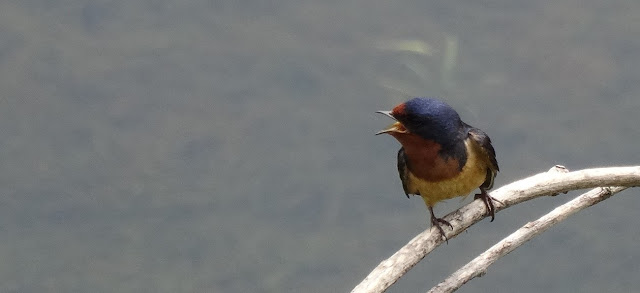7/04/2022
7/03/2022
mallard families
Female Mallard came out of the grasses with her 3 young ducks (upper right). Then, another Mallard appeared with her 8 younger ducklings. They were all intent on eating duckweed and other aquatic plants growing in the pond.
6/28/2022
On 5/20/2022 we peeked into the nest box, and found several eggs. Not countable, because of the feathers in the box meant to hide the eggs from predators. Since then I have peeked several times more.
6/19/2022
6/05/2022
5/08/2022
muskrat claws
Often we can see a muskrat swimming back and forth in the pond, harvesting plants and taking food home to the family. Muskrats Ondatra zibethica eat the roots, stems, leaves, and fruits of many water plants such as cattail, rushes, smartweed, duck potato, horsetail, sedges, and willow sprouts. They are strong swimmers due to their two long back feet and five webbed toes. For grasping and harvesting food, they have developed smaller front feet with four fingers with claws and a small thumb. By living near the pond, muskrats control plant growth, provide open spaces for new plants to grow, and make space for other animals to build their nests.
5/04/2022
5/02/2022
blue-winged teal
4/15/2022
dabblers and divers
The pond area is bustling with birds arriving! Several species of ducks have stopped for a meal or a day of rest on migration. I marvel at how they tolerate one another in this small spot of respite. Occasionally we hear honking or see disputes, but mostly the creatures get along.
Animals have adapted their method to feed in different ways. For instance, we saw Mallards feeding near Hooded Mergansers. Mallards and Blue-winged Teal are ‘dabblers' – they dip their beak and head into the water to munch on shallow-water plants. Mergansers are ‘divers' – they dive totally under the water to eat plants growing in deep water.
4/08/2022
silly gooses
4/04/2022
muskrat whiskers

12/26/2021
stars on ice
Another interesting feature of winter on the pond is the 'ice star' or 'lake star'. In my search for information about these patterns, I found many theories -- all related to the physics of temperature, moisture, pressure, and ice formation. One of these theories is that patterns are formed in early winter when a hole allows water to swell up from beneath and spread over the surface, leaving dark fingers of melted ice radiating from the hole.
12/23/2021
ice holes on pond
Cold, grey, blustery weather on the pond.
The water is covered by a thick layer of ice and snow drifts. Where the ice is visible between the drifts, a few holes break the smooth solid sheet. These seem to form where plant matter floating close to the surface or a submerged rock interrupted the process of liquid freezing to solid.
12/12/2021
11/14/2021
log in first snow
Overnight, we had the first snow of this season. On the pond, the water is high and the log was frosted with a little coat of white 'frosting'. The reeds are still green, but weakening and leaning sideways with the weight of moisture. The turtles who sun themselves on the log in summer are hibernating now. (see Surviving Below Freezing, 10/31/2020)
11/08/2021
leaf galls
This fallen leaf has galls all over it, lumps or complicated structures that look like capsules containing something mysterious. Galls are made by one of 1500 species of gall producers -- mostly insects and mites. Some galls form on leaves where insects feed on the plant matter, or lay eggs. Galls may also develop as a response to infections by fungi, bacteria, or viruses. Dissecting the gall is the only sure way to tell what caused it. That's a whole different adventure!
10/05/2021
pond lily
How nice to have a pond lily! We anticipated seeing it bloom next season. The little plant was happy in this pond, spreading out its leaves to soak up the sun and give the tuber in the mud oxygen through the underwater stems.
8/19/2021
strong stem
Ironweed is one of a few host plants for American Painted Lady butterfly. ‘Host plants’ are those that the butterfly lives on, lays eggs on, and their larvae are sustained by.
See also the post on 8-21-2020
7/23/2021
mountain mint
7/11/2021
barn swallows
Barn Swallows hunt over the pond, where they catch flying insects mid-air. To do this efficiently, they fly with their wide beaks open.
This pair found a good amount of food here, and decided to make their nest nearby. They gathered mud from the shore to paste pieces of grasses to a vertical surface in a barn, outbuilding, or nearby structure.
When their eggs hatch, the pond area will be a resource for mosquitoes and other flying insects to feed to their chicks.























